
A palengke (Chavacano: palenque) is a permanent wet market in the Philippines (differentiated from periodic wet markets called talipapa ). [1] [2] [3] [4]

A palengke (Chavacano: palenque) is a permanent wet market in the Philippines (differentiated from periodic wet markets called talipapa ). [1] [2] [3] [4]
The word palengke is a local variant of the Spanish word palenque, literally meaning "(wooden) palisade or stockade" and by extension the area enclosed by such a structure for defense, public festivals or some other purpose. [5] The Spanish word is also used to describe a pathway or cluster of tables set up at some place of gathering such as a theatre, tournament or market, [5] and it is from this latter sense that palengke likely derives its usage in the Filipino context.
In the former Spanish colonies of New Spain in the Americas palenque also described a gathering-place of indios . [5] One false etymology for palengke/palenque appearing in some popular sources mistakenly presumes that palenque is instead a word from the indigenous Mayan languages of Central America meaning "gathering place", [6] [7] and that in colonial times the Spanish adopted it to describe a gathering of indigenous groups. [6] While its use in Latin America to describe such a gathering is attested, the word itself originates from Spanish and not any of the indigenous languages; the mistaken belief of the word's indigenous origin is probably reinforced by Palenque—the famous Maya archaeological site in Chiapas, Mexico—which was named after the nearby Spanish village when the site was rediscovered in the mid-18th century. [ citation needed ]
A palengke is usually composed of several dozen stalls arranged in rows under a shared roof. Management is usually by the local governmental units whose jurisdiction encompasses the physical location of the markets. Certain pieces of legislation, however, such as the Cooperatives Code (RA 7160) and the Agriculture and Fisheries Modernization Act (RA 8435) have prescribed that management of the markets be accomplished through cooperatives. [8] There is little control over the day-to-day management of individual stalls, including commodity pricing. This has resulted in what has been called "palengke mechanics". A cited example would be the price of chicken during the local 2007 holiday season; lack of demand for the product resulted in prices going up rather than down. It was stated that this was the result of local retailers raising prices to recover financial losses from low demand. [9] The Philippine government retains some control over the price of some commodities sold in palengke, especially critical foods such as rice. [10] The National Food Authority calls this regulation campaign (specifically for rice), Palengke Watch. [11]
The concept has its criticisms, citing several drawbacks. Some are known to use wells, some illegally constructed, as water sources leading to possibly unsanitary water conditions. [12] Another criticism of the traditional palengke is that it is an old concept that must make way for modern development; a Pasig mayor once opined that the palengke was outdated. [13]
A few local politicians have used as their nicknames, such as "Mr. Palengke" (Tagalog: Palengkero; or some iteration) to signify affinity with the masses. [14] Prominent local politician Mar Roxas used the nickname Mr. Palengke to his advantage, gaining a Senate seat in the 2004 Philippine general election. [15]
In recent years, the typical palengke has been supplanted by larger, more commercialized shopping centers. The rise of shopping malls and supermarkets have also been cited as threats to the old-school public markets. In a 2002 article, the president of the National Federation of Market Vendors Cooperatives, a cooperative of market vendors throughout the country, stated that the concept of the palengke was an integral part of Philippine culture. He stressed that the public market instilled a sense of community that was not evident in the more-commercialized shopping malls. [8] In spite of this, at least one traditional market has been renovated to appeal to more commercialized consumers. A specific case is the "Mutya ng Pasig Market" which was renovated in late 2008, from a traditional palengke into more of a shopping mall. [13]

The Visayas, or the Visayan Islands, are one of the three principal geographical divisions of the Philippines, along with Luzon and Mindanao. Located in the central part of the archipelago, it consists of several islands, primarily surrounding the Visayan Sea, although the Visayas are also considered the northeast extremity of the entire Sulu Sea. Its inhabitants are predominantly the Visayan peoples.

Filipino is a language under the Austronesian language family. It is the national language of the Philippines, and one of the two official languages of the country, with English. It is a standardized variety of Tagalog based on the native dialect, spoken and written, in Metro Manila, the National Capital Region, and in other urban centers of the archipelago. The 1987 Constitution mandates that Filipino be further enriched and developed by the other languages of the Philippines.
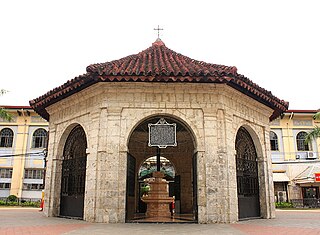
Cebu City, officially the City of Cebu, is a 1st class highly urbanized city in the Central Visayas region of the Philippines. It is the capital of the Cebu Province, where it is geographically located but is one of three cities that are administratively independent of the provincial government. According to the 2020 census, it has a population of 964,169 people, making it the sixth-most populated city in the nation and the most populous in the Visayas.
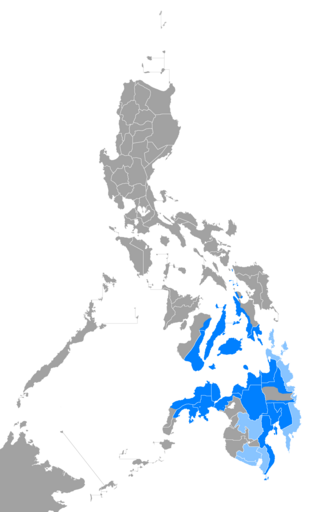
Cebuano is an Austronesian language spoken in the southern Philippines. It is natively called by its generic term Bisayâ or Binisayâ and sometimes referred to in English sources as Cebuan. It is spoken by the Visayan ethnolinguistic groups native to the islands of Cebu, Bohol, Siquijor, the eastern half of Negros, the western half of Leyte, and the northern coastal areas of Northern Mindanao and the Zamboanga Peninsula. In modern times, it has also spread to the Davao Region, Cotabato, Camiguin, parts of the Dinagat Islands, and the lowland regions of Caraga, often displacing native languages in those areas.

Pasig, officially the City of Pasig, is a highly urbanized city in the National Capital Region of the Philippines. According to the 2020 census, it has a population of 803,159 people.

Antipolo, officially the City of Antipolo, is a 1st class component city and capital of the province of Rizal, Philippines. According to the 2020 census, it has a population of 887,399 people. It is the most populous city in the Calabarzon region, and the seventh most-populous city in the Philippines. And also, it is the most populated city under the component city status.
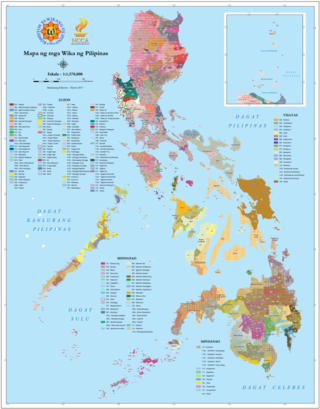
There are some 130 to 195 languages spoken in the Philippines, depending on the method of classification. Almost all are Malayo-Polynesian languages native to the archipelago. A number of Spanish-influenced creole varieties generally called Chavacano along with some local varieties of Chinese are also spoken in certain communities. The 1987 constitution designates Filipino, a standardized version of Tagalog, as the national language and an official language along with English. Filipino is regulated by Commission on the Filipino Language and serves as a lingua franca used by Filipinos of various ethnolinguistic backgrounds.
SM Supermalls, also simply known as SM is a chain of shopping malls owned by Philippines-based SM Prime. As of October 2023, it has a total of 93 malls. It was also formerly known as Shoemart.
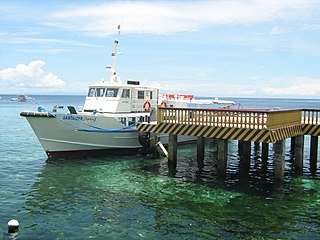
Santander, officially the Municipality of Santander, is a 4th class municipality in the province of Cebu, Philippines. According to the 2020 census, it has a population of 18,527 people.

Danao, officially the City of Danao, is a 3rd class component city in the province of Cebu, Philippines. According to the 2020 census, it has a population of 156,321 people.

Calasiao, officially the Municipality of Calasiao, is a 1st class municipality in the province of Pangasinan, Philippines. According to the 2020 census, it has a population of 100,471 people.
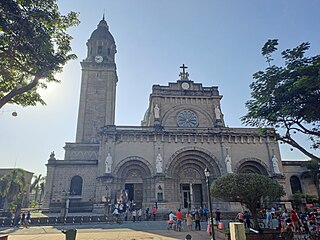
As part of the worldwide Catholic Church, the Catholic Church in the Philippines, or the Filipino Catholic Church, is under the spiritual direction of the Pope. The Philippines is one of the two nations in Asia having a substantial portion of the population professing the Catholic faith, along with East Timor, and has the third largest Catholic population in the world after Brazil and Mexico. The episcopal conference responsible in governing the faith is the Catholic Bishops' Conference of the Philippines (CBCP).

Divisoria is a commercial center in the districts of Tondo, Binondo, and San Nicolas in Manila, Philippines known for its shops that sell low-priced goods and its diverse manufacturing activities. Tutuban Center is situated within the commercial hub along with a night market located in the Centers' vicinity. The area is riddled with different bazaars, bargain malls, and a few points of interest.

Colon Street is a historical street in Cebu City. Located in the city's downtown, Colon Street is often referred to as the oldest and the shortest national road in the Philippines. It is named after Cristóbal Colón. Built in 1565, the street traces its origins to Miguel Lopez de Legazpi, the Spanish conquistador who arrived in the Philippines to establish a colony in the 16th century, and eventually developed the street under his leadership.
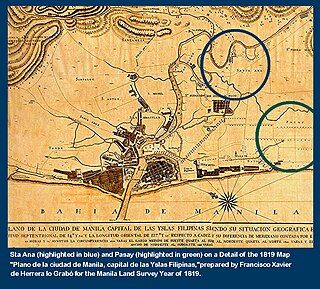
Namayan, also called Sapa, Maysapan, and sometimes Lamayan, was an independent indigenous polity on the banks of the Pasig River in the Philippines. It is believed to have achieved its peak in 1175, and to have gone into decline sometime in the 13th century, although it continued to be inhabited until the arrival of European colonizers in the 1570s.

Ayala Malls is a retail subsidiary of real estate company Ayala Land, an affiliate of Ayala Corporation. Founded in 1988, Ayala Malls own a chain of large shopping malls, all located in the Philippines. Ayala Malls is one of the largest shopping mall retailer in the Philippines, along with SM Supermalls and Robinsons Malls.

In Philippine history, the Tagalog bayan of Maynila was one of the most cosmopolitan of the early historic settlements on the Philippine archipelago. Fortified with a wooden palisade which was appropriate for the predominant battle tactics of its time, it lay on the southern part of the Pasig River delta, where the district of Intramuros in Manila currently stands, and across the river from the separately-led Tondo polity.

The Carbon Market is the largest market in Cebu City, Philippines. It is the oldest market in the Central Visayas region. As the largest market in the city, various wares are sold in Carbon, including dry goods such as clothing, kitchenware, and handicrafts, as well as wet goods, such as fruits, vegetables, and meat, among other goods, sold by approximately 6,000 vendors in the market.

An ukay-ukay, or wagwagan is a Philippine store where secondhand items such as clothes, bags, shoes and other accessories are sold at a cheap price. Items commonly sold at ukay-ukay's are imported from European and North American countries.

Quinta Market, also known as Quiapo Market and officially called the Quinta Market and Fishport since 2017, is a palengke on Carlos Palanca Street in Quiapo, Manila, in the Philippines, along the banks of the Pasig River.
The wet market is a set of stalls selling fruits and vegetables, either grouped outside or under one roof, either periodic (called a talipapa) or permanent (called a palengke)